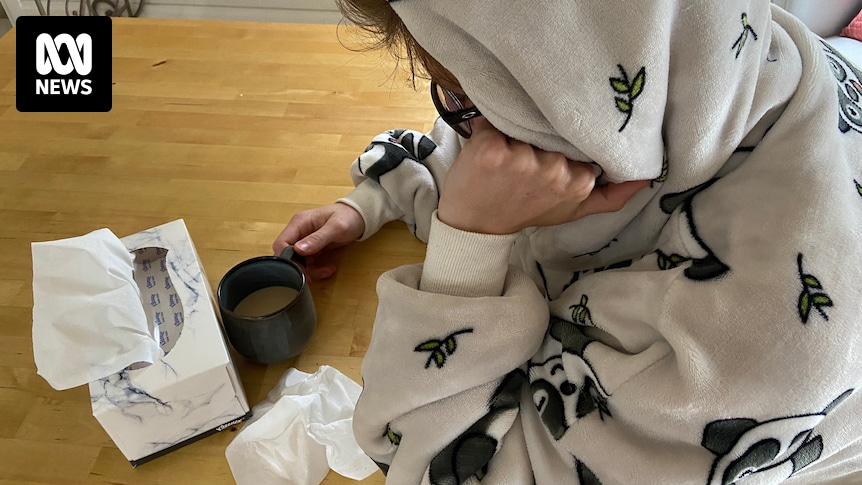You’ve already taken a sick day to recover from a cold and you’re feeling a bit better, but still not 100 per cent.
So do you go back to work or take another day off?
Here’s how to work out what’s best for you.
How long does it take to recover from a cold?
“Most people recover from a cold within seven to 10 days without any treatment, says Todd Miller, the acting chief medical officer for government-funded health website Healthdirect Australia.
But recovery times vary — not just depending on the virus, but depending on the individual.
“Medical conditions and other lifestyle factors can have a significant impact on your immune system and, therefore, recovery times,” Dr Miller says.
How long should you be off sick with a cold?
That’s hard to say because everyone’s different.
But it could be a few days, says Sanjaya Senanayake, an infectious diseases doctor and senior staff specialist at Canberra Hospital.
“If you are sick with the flu, RSV or COVID, those first few days when you have symptoms are when you should be staying at home,” Dr Senanayake says.
But you could still be shedding the virus after three to five days, meaning you could infect your colleagues.
When should you go back to work or school?
Dr Miller says people should consider going back to work or school when they feel well or “when their acute symptoms are gone“.
Acute symptoms to look out for include:
- fever
- runny nose
- sneezing
- coughing
- sore throat
“Additionally, because several viruses can cause a cold-like illness, it’s possible to have several colds one after the other because a different virus causes each one,” Dr Miller says.
What if you’re feeling ‘mostly’ better?
“If someone is feeling mostly better, but isn’t sure if they’re still contagious, they may consider wearing a mask and maintaining physical distancing wherever possible,” Dr Miller says.
“You should also practise good hand hygiene.
“If you’re able to work from home, you should do so.
“It is possible that you may remain infectious despite no longer displaying symptoms and it is also likely that you were infectious prior to displaying symptoms.”
Dr Senanayake says since the pandemic, most people are used to seeing face masks.
“If you’re past those first few days and now your symptoms are resolved … then maybe for a couple of days wear a mask and say you’ve had a viral infection,” he says.
Let’s say you’re not coughing but you’ve still got a headache and are feeling a bit “meh”.
You might think that technically you can still work, but Dr Senanayake points out that you still have a headache and are feeling lousy.
“If you’re sick, you’re sick,” he says.
Can going back too early make it worse?
“Returning to work or school too early can prolong the symptoms of colds, flu and similar respiratory viruses as it may impact your ability to rest and maintain hydration,” Dr Miller says.
“Additionally, exposure to stress — both physical and mental — can have a negative impact on your immune system.”
Am I entitled to paid sick leave?
All employees are entitled to sick leave, except for people employed as casuals, the Fair Work Ombudsman’s website says.
How many paid sick days do you get each year?
Full-time employees are entitled to 10 days of paid sick leave a year.
It’s pro-rata for part-time employees, meaning it depends on how many hours they work.
“This can be calculated as 1/26 of an employee’s ordinary hours of work in a year,” the ombudsman’s website says.
However, sick leave accumulates over the years, so whatever sick days you don’t use in one year carry over to the next year.
And the ombudsman says employees can take as much sick leave as they’ve accumulated. As long as they’ve banked up the leave, there’s no limit to how much they can take at one time.
How many days can you take off before needing a medical certificate?
That depends on your workplace.
The ombudsman’s website says employees can be asked to provide evidence “for as little as one day or less off work”.
“An employee who doesn’t give their employer evidence when asked may not be entitled to be paid for their sick or carer’s leave,” the ombudsman says.
It’s a good idea to look at the terms of your employment award or agreement for details about this.
However, the ombudsman says the type of evidence requested “must always be reasonable in the circumstances”.
What kind of evidence do you need to provide to take sick leave?
There are no strict rules on that.
The ombudsman says it just has to be to “convince a reasonable person that the employee was genuinely entitled to the sick or carer’s leave”.
Usually, it’s a medical certificate, which you can get from a doctor and some pharmacies.
But a statutory declaration can also be an acceptable form of evidence.
People with MyGov accounts can submit a Digital Commonwealth statutory declaration without needing a physical witness.
